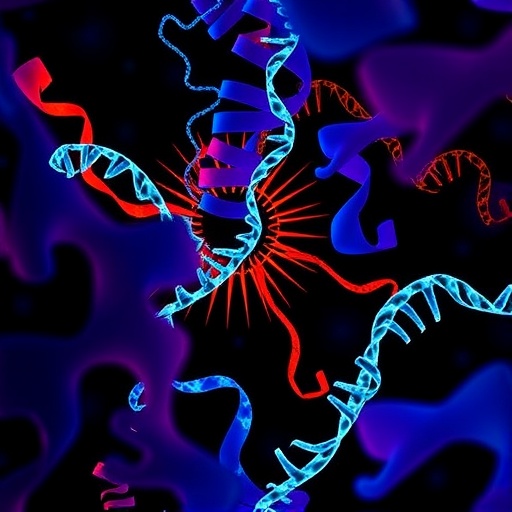In a groundbreaking study poised to reshape our understanding of how cells preserve genomic integrity during DNA replication, researchers have identified KCTD10 as a critical sensor and facilitator in the resolution of transcription–replication conflicts (TRCs). These conflicts, often occurring when the machinery responsible for copying DNA collides with the transcription apparatus that reads DNA to make RNA, pose significant threats to genome stability and proper cell function. The research reveals that KCTD10 not only identifies these stall points but also recruits key molecular machinery necessary for resolving them.
At the heart of these processes lies the interaction between KCTD10 and CUL3, a component of the ubiquitin ligase complex responsible for tagging proteins for degradation or functional modification. The study demonstrates that KCTD10 forms complexes with both proliferating cell nuclear antigen (PCNA), a marker of DNA replication, and RNA polymerase II (RNAP) complexes. These interactions become especially pronounced upon treatment with the catalytic topoisomerase II (TOP2) inhibitor ICRF193, suggesting that KCTD10 response is finely tuned to specific replication stressors involving TOP2 activity.
By using size-exclusion chromatography, the researchers distinguished distinct protein fractions, showing that in normal cells, KCTD10 and PCNA co-elute with only partial overlap with POLR2A, the large subunit of RNAP II. In contrast, upon ICRF193 treatment, all three proteins co-elute—an indicator of a tightly coordinated interaction at TRCs. This co-elution implies that KCTD10 supports the formation of protein complexes bridging DNA replication and transcription machinery under replication stress conditions.
Immunoprecipitation assays further confirmed these associations: KCTD10 physically associates with both PCNA and POLR2A after ICRF193 treatment, whereas under non-stressed conditions, its interaction with POLR2A is minimal. This suggests an inducible binding mechanism, where KCTD10 responds adaptively to the presence of stalled or collided replication forks and transcription complexes, thereby positioning itself as a molecular signal transducer at sites of genomic stress.
Functional validation of KCTD10’s role was accomplished using Proximity Ligation Assays (PLA) to detect spatial proximity between CUL3 and POLR2A within cells. These assays revealed a significant increase in CUL3–POLR2A proximities in cells subjected to ICRF193, consistent with active recruitment of CUL3 to TRCs. Strikingly, knocking out KCTD10 abolished this response, underscoring KCTD10’s indispensable role in bridging CUL3 to the RNA polymerase machinery during replication-associated DNA damage.
The specificity of this response was elegantly demonstrated in experiments inducing co-directional TRCs in engineered HEK293T cells carrying an ECFP reporter. Here, induced TRCs similarly triggered an increase in CUL3–POLR2A proximity, validating the physiological relevance of the KCTD10–CUL3 axis in resolving conflicts arising from transcription and replication occurring in the same orientation on DNA. Moreover, this KCTD10-dependent recruitment did not occur with DNA damage induced by etoposide, a TOP2 poison that stabilizes DNA cleavage complexes differently from ICRF193, highlighting the nuanced molecular specificity of this pathway.
A further layer of functional insight was provided by experiments manipulating KCTD10 dimerization. Utilizing a modified FKBP domain (DmrB) fused to KCTD10, researchers showed that chemically induced dimerization enhanced CUL3 co-immunoprecipitation. This artificial induction of KCTD10 oligomerization mimicked the natural activation mechanism, suggesting that KCTD10 dimerization or oligomerization is a crucial event signaling CUL3 recruitment during TRC resolution.
Intriguingly, CUL3 recruitment to transcription complexes was abolished in quiescent, G1-arrested cells, indicating that the replication machinery’s active engagement is essential for this pathway’s activation. This points to a model where replication stress, particularly during S-phase, primes KCTD10 to identify and respond to TRCs by scaffolding interactions with PCNA and RNAP.
The importance of PCNA in this molecular interplay was underscored by experiments inhibiting its chromatin loading, which greatly diminished CUL3–POLR2A proximity signals. Similarly, mutating the PIP box—a motif in KCTD10 mediating PCNA binding—reduced proximity complexes and heightened cellular sensitivity to ICRF193, further affirming that PCNA directly contributes to signaling and stabilizing the recruitment of ubiquitination machinery to TRCs.
Not only does this work uncover the molecular choreography at stalled replication-transcription interfaces, but it also highlights the functional consequences of disrupting this axis. Inhibition of CUL3 enzymatic activity via MLN4924, a neddylation inhibitor, led to an accumulation of unresolved TRCs independent of KCTD10 availability, underscoring that KCTD10-mediated recruitment of CUL3 is vital for the ubiquitin-dependent resolution of transcription-replication conflicts.
At the structural level, AlphaFold2-multimer predictions provided atomic insights into how KCTD10 interacts with subunits of the RNAP complex, particularly POLR2C and the transcription elongation factor TCEA2. Notably, these predictions identified a novel supersecondary structural feature within KCTD10, which might underlie its capability to recognize and interface with the transcription machinery, providing a mechanistic understanding of its sensing function.
Mutational analyses further solidified the mechanistic framework, with the R167A mutant of KCTD10, defective in dimerization, failing to restore CUL3 recruitment to RNAP complexes in cells treated with ICRF193. This highlights the critical nature of KCTD10’s oligomerization in orchestrating downstream ubiquitination events necessary for TRC resolution.
These findings collectively introduce KCTD10 as a pivotal molecular sensor and platform in the maintenance of genome stability during DNA replication. By selectively recruiting CUL3 upon recognizing transcription-replication conflicts, KCTD10 orchestrates a timely ubiquitin-dependent resolution mechanism, shielding the genome from deleterious collisions between DNA synthesis and transcription processes.
This discovery not only deepens our molecular understanding of replication stress responses but also opens new avenues to explore therapeutic interventions targeting TRC resolution pathways. Given the intricate involvement of TOP2 inhibitors like ICRF193 in cancer therapy, deciphering the KCTD10–CUL3 axis could inform strategies to modulate cellular responses to replication stress and enhance treatment efficacy.
As researchers continue to dissect the dynamics of TRCs, KCTD10 emerges as a central hub translating replication-transcription collision signals into ubiquitin-mediated repair, representing an exciting frontier in molecular cell biology with implications for genomic stability and cancer biology.
Subject of Research: Transcription–Replication Conflicts and Genome Stability
Article Title: KCTD10 is a sensor for co-directional transcription–replication conflicts
Article References:
Kloeber, J.A., Chen, B., Sun, G. et al. KCTD10 is a sensor for co-directional transcription–replication conflicts. Nature (2025). https://doi.org/10.1038/s41586-025-09585-9
Image Credits: AI Generated




